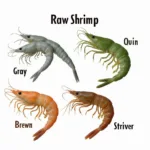Seahorses are fascinating creatures known for their unique shape and ability to camouflage. But what color is a seahorse? The answer isn’t as straightforward as you might think. Their coloration varies dramatically depending on the species and their environment. Understanding this incredible adaptation provides a glimpse into the fascinating world of these underwater masters of disguise.
Decoding Seahorse Colors: A Spectrum of Disguise
Seahorses possess a remarkable ability to change color, blending seamlessly with their surroundings. This camouflage is crucial for both hunting and avoiding predators. While the specific colors vary widely, some common seahorse hues include shades of green, yellow, brown, red, orange, and even black and white. what colors are seahorses Some species can even display intricate patterns and markings to enhance their camouflage. This adaptability allows them to thrive in diverse habitats, from coral reefs and seagrass beds to mangrove forests and rocky shores.
Common Seahorse Color Variations
- Greens and Yellows: These colors are often seen in seahorses living amongst seagrass and algae. The shades can range from a vibrant lime green to a more subdued olive or a pale, almost translucent yellow.
- Browns and Reds: Seahorses inhabiting coral reefs or areas with rocky substrates often display browns and reds. These colors help them blend in with the corals, sponges, and other organisms in their environment.
- Oranges and Pinks: These brighter hues are less common but can be seen in some species. They may be used for courtship displays or as a warning signal to predators.
- Black and White: Certain seahorse species can even display black and white coloration, particularly those found in areas with contrasting light and dark patterns.
The Science Behind Seahorse Color Change
How do seahorses achieve this impressive color-changing feat? Specialized pigment cells called chromatophores, located in their skin, are responsible for this remarkable adaptation. These cells contain pigments that can expand or contract, altering the color displayed. This process is controlled by the seahorse’s nervous system and is influenced by factors like environmental conditions, mood, and even social interactions.
Factors Influencing Seahorse Coloration
- Habitat: The surrounding environment plays a significant role in a seahorse’s coloration. They adapt to match the colors and patterns of their habitat, maximizing their camouflage.
- Mood: Seahorses can change color based on their emotional state. For example, they might become darker when stressed or display brighter colors during courtship rituals.
- Social Interactions: Color changes can also be used for communication between seahorses. They may display specific colors to attract mates or to signal aggression towards rivals.
What Colors Go With Camouflage? A Seahorse Perspective
From a seahorse’s perspective, the best colors for camouflage are those that match their immediate surroundings. This means that the ideal color palette can vary significantly depending on the specific habitat. Seahorses have evolved to perfectly blend in, proving that the most effective camouflage is context-dependent. what colors go with camouflage
 Seahorse Camouflaged in a Coral Reef
Seahorse Camouflaged in a Coral Reef
Conclusion
So, what color is a seahorse? It depends! Their remarkable ability to change color makes them true chameleons of the sea. From vibrant greens and yellows to subtle browns and reds, seahorses have evolved a dazzling array of colors and patterns to thrive in their diverse and challenging underwater world. Understanding the factors that influence their coloration provides valuable insights into the fascinating lives of these unique creatures.
FAQs
- Can all seahorses change color? Yes, all seahorses possess the ability to change color to some degree.
- How fast can a seahorse change color? The speed of color change can vary depending on the species and the situation, but it can happen quite rapidly, often within seconds or minutes.
- What is the purpose of seahorse camouflage? Camouflage is essential for both predator avoidance and successful hunting.
- Do seahorses use color for communication? Yes, seahorses can use color changes to communicate with each other, particularly during courtship displays.
- What is the rarest seahorse color? While specific colors vary by species, some rare seahorse variations include vibrant pinks, electric blues, and deep purples.
- How does a seahorse’s habitat influence its color? The surrounding environment is a primary factor influencing a seahorse’s coloration, as they adapt to match the colors and patterns of their habitat.
- Are there any seahorses that cannot change color? No, all seahorses have the ability to change color, although the extent and range of colors can vary.
Seahorse Color Change Situations
- Hiding from Predators: A seahorse might turn a mottled brown to blend in with seaweed or a vibrant yellow to match a sponge.
- Hunting Prey: Remaining camouflaged allows a seahorse to ambush unsuspecting small crustaceans.
- Courtship: Males might display brighter colors or intricate patterns to attract a female.
- Stress: A seahorse might darken its color when feeling threatened or stressed.
Further Exploration
For more information on seahorse coloration and other fascinating facts about these unique creatures, check out these additional resources:
- Explore the diversity of seahorse species and their habitats.
- Learn more about the science of animal camouflage and color change.
Need Help with Your Own Color Transformations?
Whether you’re inspired by the adaptive camouflage of seahorses or simply looking to refresh your living space, Color Box Hanoi can help! Contact us for expert advice on paint colors and design. Call us at 0373298888, email us at [email protected], or visit our showroom at 86 Cau Giay, Hanoi. We have a 24/7 customer service team ready to assist you.

